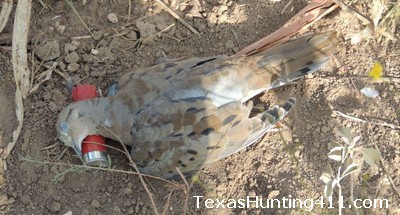White-winged and mourning dove hunting is the most popular form of hunting in Texas. More hunters shoot doves than any other game species. Mourning dove populations occur from southern Canada to northern Mexico. Texas produces millions of new birds thanks to dove nesting activity, but millions more doves migrate south every winter to avoid cold temps and to find food. They usually leave their northern range and travel south from September through February and return to their breeding grounds from March through August. Migration, fortunately for hunters, corresponds with dove hunting season in Texas.
Texas has a large resident population of mourning doves, which is well-supplemented by northern migrants that over winter here. Most of our migrant mourning doves come from the north central states. However, research surveys have shown that over 80% of the doves harvested in Texas are resident birds. This means dove hunting targets primarily locally produced birds, meaning nesting habitat and breeding is important. In Texas, the breeding season usually peaks in late spring and early summer. Nests are usually about 15 feet from the ground and are often along field and pasture edges or adjacent to other open areas.

Two eggs are laid in the nest and incubation begins immediately after both eggs are laid. Eggs hatch in 14 days and the young are fed pigeon milk (a milky substance produced in the dove’s crop) and partially digested seeds by both parents until they are ready to leave the nest. The young doves, or squabs, develop rapidly and can fly at around 12 days old. Soon after the young leave the nest the adults begin preparation for a second brood, often using the same nest.
In Texas, three to seven broods may be produced each year. The life span of wild mourning doves may exceed 5 years but the annual natural mortality in the continental population is 70% whether there is hunting or not. Much of the population data about doves is collected when hunters report dove bands. Each year in Texas, thousands of mounring and white-winged doves are banded for the purposes of getting more information about these important game species.
Habitat Preferences of Mourning Doves
Mourning doves primarily feed on various seeds including waste grain, native and cultivated grasses and occasionally feed on small traces of insect matter. Large open cultivated fields of millet, sunflower, corn, wheat, soybeans and peanuts often attract large numbers of birds. Harvested ag fields, as hunters know, offer good dove hunting in the early fall. In addition to crops, Carolina cranesbill, dove weed (woolly croton), morning glory, pokeberry, ragweed, spiny pigweed, bristle grass are some native foods doves highly prefer. Doves rarely scratch the ground for food and seeds must be on open ground where they can easily be seen. Mourning doves will often sit on power lines, trees, or snags prior to flying down in to a field.
Mourning doves must have grit (sand and gravel) in their gizzard to help grind food. Often doves are seen in dirt roads or along the edge of paved roads picking up grit. Doves also require water daily and prefer to get water from ponds, streams and puddles that have clear banks and edges with a gentle slope to the water. Dove hunters also take advantage of this, dove hunting around stock tanks in the afternoon until shooting time ends.